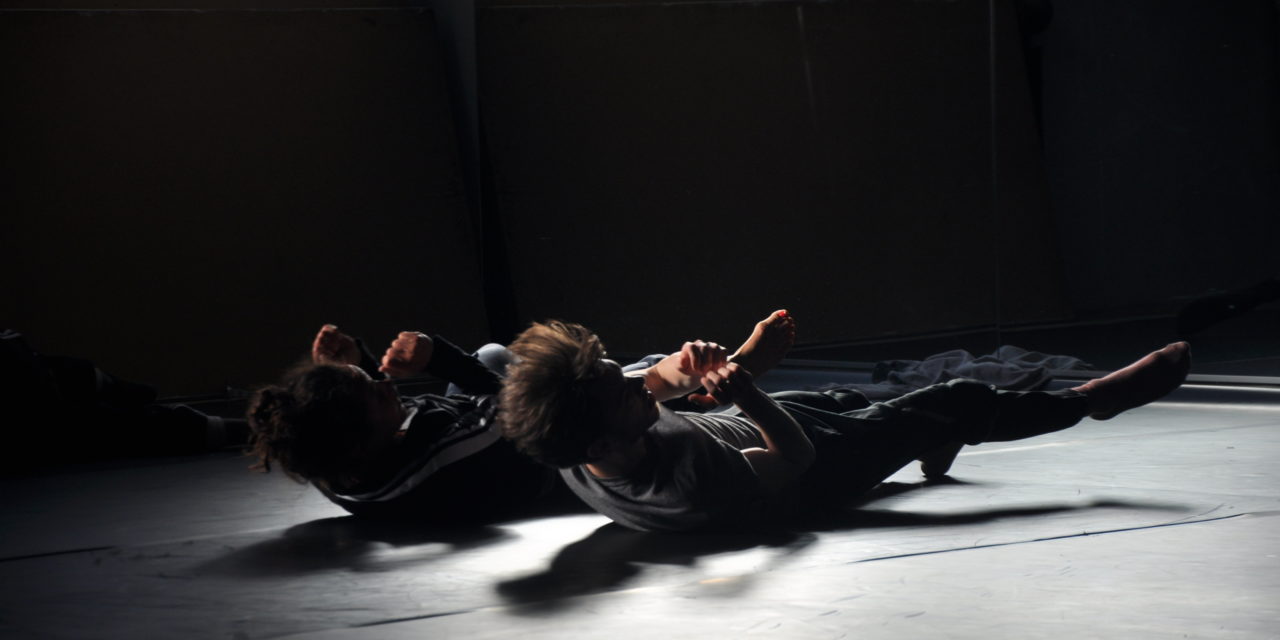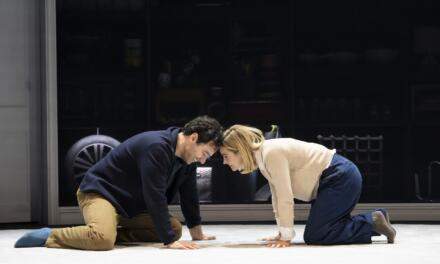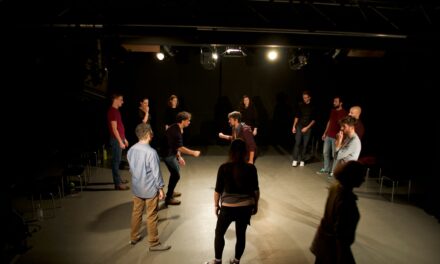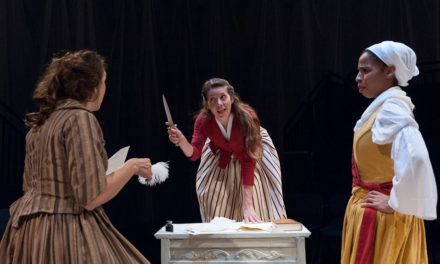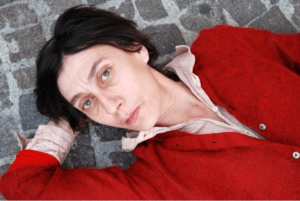 Germana Civera, choreographer and performance artist from Spain based in Montpellier, France, just completed a two-week residency with Core Performance Company, Atlanta. The performance Human Landscapes–The Migration Of Beings, Gestures, And Stories was born from this residency and then it was presented to the public at The B-Complex from October 26 to October 29, 2017, as part of France-Atlanta 2017. Germana shared time with us on her way back to Montpellier.
Germana Civera, choreographer and performance artist from Spain based in Montpellier, France, just completed a two-week residency with Core Performance Company, Atlanta. The performance Human Landscapes–The Migration Of Beings, Gestures, And Stories was born from this residency and then it was presented to the public at The B-Complex from October 26 to October 29, 2017, as part of France-Atlanta 2017. Germana shared time with us on her way back to Montpellier.
Nicole Birmann Bloom: Dear Germana, could you tell us more about your two-week residency with Core Performance Company?
Germana Civera: The two-week residency with Core Performance Company was dedicated to the creation of the performance piece Human Landscapes. It was rich with encounters, exchanges and…yes, dis-placements.
Extra time was held to develop artistic interactions–workshop with non-professionals, lectures and talks that led to a better awareness of the cultural and artistic environment of Atlanta, to a better knowledge of the diversity of the audience that included children and refugees. Then, all these elements merged in several performances that were presented at The B Complex Gallery, a deserted industrial space. This is how we participated in the France-Atlanta Festival in this open and diverse context.
Nicole: How did you meet with Core Performance Company? Who were the dancers?
Germana: This was an unexpected and direct encounter. We met in France at the Centre De Developpement Chorégraphique (CDC) in Toulouse. I was there as a teacher for the professional training program called Extensions. Core Performance Company was there too, performing in Toulouse, the Pink City; they came to my morning class and we met. My way of working blended extremely well with their curiosity, their availability and ability to understand the work. It was “a coup de foudre,” love at first sight. Then later, Sue Schroeder, the artistic director of Core came to Toulouse to meet with me and six months later, she invited me to work with them. Genial!
Nicole: Was it your first experience in the United States?
Germana: As a dancer, I had the opportunity to dance in New York and Washington when we toured with French artists I worked with, a while ago. As a choreographer, it is the first time I have presented my work in the United States.
Nicole: Human Landscapes deals with questions related to exile and migrations. What led you to approach this specific topic while being in Atlanta? What were the most challenging moments with the dancers and what surprised you?
Germana: Professor Alexis Nouss would say “suspension between space and time:” the link between Europe and America is the perfect illustration of what he named “exiliance” (*).
The subject of otherness is at the heart of my artistic process. To be more accurate, my research is based upon exchange and circulation, far from any concern related to ownership. So the encounter is part of my work process and artistic intention. Dance is par excellence an artistic practice that travels, moves from one place to the other; it also maintains an open eye and dialogue with and towards the world. I am a woman, a mother, a citizen, and a witness of the global migrant phenomenon. This moves me, dis-places me, and sets me up in a creative movement. I am deeply stirred by questions of “exiliance” because I am a person living in exile. So, obviously, the time came for me to more deeply investigate the subject and share this experience through a work such as Human Landscapes.
After one performance, I had a very precious encounter with an audience member, a woman refugee from Libia, who came to express her gratitude towards the work and how she felt deeply touched by it. It was moving for both of us.
All dancers participating in the project surprised me with their artistic and physical potentials. The ensemble (or company) of Core Performance Company is built on qualities of attention, listening and curiosity. They all had the desire to go beyond what is possible. The most interesting moment and also the most delicate came up when we started to enter new territories. We had to go towards the unknown and above one’s own limits, such as getting rid of preconception and models. It is essential for an artistic project and we did it.
Nicole: Could you describe your work with Didier Aschour, Director of Centre national de création musicale (GMEA), in Albi, in relation to Human Landscapes.
Germana: With Didier, we have been working together for a long time. It is a collaboration I deeply value. Our research has mutual resonance and looks towards similar goals. It is as if we read the mind of the other; we don’t need much time talking.
For Human Landscapes, I imagined a musical and sound score that would bring together several styles and patterns interweaving each other in a non-linear way. It would take elements from diverse sources: Literature, cinema, music…I shared my ideas with Didier wondering if it was possible. It looked complicated but Didier devised the perfect system that I used and nurtured with great pleasure and artistic endeavor. This system is freely inspired by Circus On (also known as Roaratorio), the 1979 score by John Cage, based upon James Joyce Finnegans Wake.
Nicole: What is your next project?
Germana: These days, I am deep into Musique Rapide Et Lente, based upon the book of the same name (published in 2014) by Cyrille Martinez with whom I have been working for a while. Didier is also part of this new work. It is about adolescence, how teens see the world in general, and more specifically the art world. For the two past years, I have met with teens from various classes and cities of the South of France (Sète, Nîmes, Montpellier).
My work deals with the transversality of the arts, but I also attempt to bring together the art of dance and people. Dance is not just one hour of performance. Dance, for me, is to give substance and sense to dance as a live art, and it also happens during non-spectacular actions such as workshops. And I pursue this goal with awareness, persistence and pleasure.
Today the creation of Musique Rapide Et Lente involves a group of young teens, a new generation with promising futures. It will be at Théâtre le Périscope, in Nîmes, on March 9 and 10, 2018.
Thank you !
To know more about Germana’s experience in Atlanta, watch here
(*) Concept Of Exiliance by Prof. Alexis Nouss: Condition And Consciousness
As an existential core in the experience lived by all migrants, whatever the historical and cultural circumstances are, exiliance is both a condition and a consciousness. However, they may not be in sync: one could feel in exile without really be exiled or one could be exiled without feeling it. Among other sources, Kafla’s America provides the material to study this phenomenon in its ethical dimension. Other issues to be addressed are the representation of exilic experience and the link between death and exile.
Interview conducted in November 2017 by Nicole Birmann Bloom, Program Officer Performing Arts
This post originally appeared on French Culture in November 2017, and has been reposted with permission.
This post was written by the author in their personal capacity.The opinions expressed in this article are the author’s own and do not reflect the view of The Theatre Times, their staff or collaborators.
This post was written by Nicole Birmann.
The views expressed here belong to the author and do not necessarily reflect our views and opinions.

